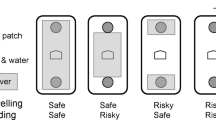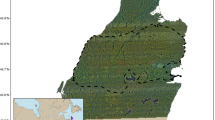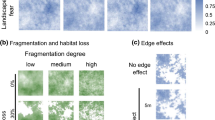Abstract
Understanding the distribution of individuals in space is a primary concern to ecologists and managers. With the advent of remote monitoring technology, we have been able to answer where individuals are but we often lack an understanding of why they are located in a particular place from a behavioral perspective. Increasingly, ecologists are becoming aware of the crucial role individual behavior may play in ecological processes. The movement of individuals within fragmented landscapes is no exception. We used a dynamic state variable model to explicitly account for the behavioral trade-off between acquiring forage and predation risk in a spatial context. We found that when individuals were able to become behaviorally unavailable for predation within a patch as a result of their energetic state, foraging strategy, or the effectiveness of anti-predator behaviors, they were able to mitigate the potential travel costs associated with the spatial configuration of patches to use riskier patches. However, when this was not possible, patch choice became an effective way of minimizing the risk of predation. Individuals appear to trade-off predation risk and the acquisition of forage in a hierarchical fashion depending on whether or not the spatial arrangement and context of patches constrained their anti-predator behavior. We suggest that a better understanding how patch selection and the behavioral trade-offs associated with predation risk occur at multiple scales may help bridge the gap between animal behavior and landscape ecology.





Similar content being viewed by others
References
Andreassen H, Hertzberg K, Ims R (1998) Space-use responses to habitat fragmentation and connectivity in the root vole Microtus oeconomus. Ecology 79(4):1223–1235
Anholt B, Werner E (1995) Interaction between food availability and predation mortality mediated by adaptive behaviour. Ecology 76(7):2230–2234
Bailey D, Gross J, Laca E, Rittenhouse L, Coughenour M, Swift D, Sims P (1996) Mechanisms that result in large herbivore grazing distribution patterns. J Range Manag 49(5):386–400
Banks P, Norrdahl K, Korpimaki E (2000) Nonlinearity in the predation risk of prey mobility. Proc Royal Soc London Ser B-Biol Sci 267(1453):1621–1625
Basille M, Fortin D, Dussault C, Bastille-Rousseau G, Ouellet JP, Courtois R (2015) Plastic response of fearful prey to the spatiotemporal dynamics of predator distribution. Ecology 96(10):2622–2631
Bastille-Rousseau G, Potts JR, Schaefer JA, Lewis MA, Ellington EH, Rayl ND, Mahoney SP, Murray DL (2015) Unveiling trade-offs in resource selection of migratory caribou using a mechanistic movement model of availability. Ecography 38(10):1049–1059
Belisle M (2005) Measuring landscape connectivity: the challenge of behavioral landscape ecology. Ecology 86 (8):1988–1995
Berger-Tal O, Bar-David S (2015) Recursive movement patterns: review and synthesis across species. Ecosphere 6(9):1–12
Berger-Tal O, Embar K, Kotler BP, Saltz D (2014) Past experiences and future expectations generate context-dependent costs of foraging. Behav Ecol Sociobiol 68(11):1769–1776
Berger-Tal O, Blumstein DT, Carroll S, Fisher RN, Mesnick SL, Owen MA, Saltz D, St Clair CC, Swaisgood RR (2015) A systematic survey of the integration of behavior into wildlife conservation and management. Conserv Biol
Bonnot N, Verheyden H, Blanchard P, Cote J, Debeffe L, Cargnelutti B, Klein F, Hewison AM, Morellet N (2015) Interindividual variability in habitat use: evidence for a risk management syndrome in roe deer? Behav Ecol 26(1):105–114
Bowyer R, Kie J (2006) Effects of scale on interpreting life-history characteristics of ungulates and carnivores. Divers Distrib 12(3):244–257
Boyce M, McDonald L (1999) Relating populations to habitats using resource selection functions. Trends Ecol Evol 14(7):268–272
Brown J (1999) Vigilance, patch use and habitat selection: foraging under predation risk. Evol Ecol Res 1 (1):49–71
Brown J, Kotler B (2004) Hazardous duty pay and the foraging cost of predation. Ecol Lett 7(10):999–1014
Caro T (2005) Antipredator defenses in birds and mammals. University of Chicago Press, Chicago
Charnov E (1976) Optimal foraging—marginal value theorem. Theor Popul Biol 9(2):129–136
Clark C, Mangel M (2000) Dynamic state variable model in ecology. Oxford University Press, Oxford
Cook R, Cook J, Murray D, Zager P, Johnson B, Gratson M (2001) Development of predictive models of nutritional condition for Rocky Mountain elk. J Wildlife Manag 65(4):973–987
Courbin N, Fortin D, Dussault C, Courtois R (2014) Logging-induced changes in habitat network connectivity shape behavioral interactions in the wolf–caribou–moose system. Ecol Monograph 84(2):265–285
Creel S, Winnie J (2005) Responses of elk herd size to fine-scale spatial and temporal variation in the risk of predation by wolves. Animal Behav 69:1181–1189
Creel S, Winnie J, Maxwell B, Hamlin K, Creel M (2005) Elk alter habitat selection as an antipredator response to wolves. Ecology 86(12):3387–3397
Dall SR, Giraldeau LA, Olsson O, McNamara JM, Stephens DW (2005) Information and its use by animals in evolutionary ecology. Trends Ecol Evol 20(4):187–193
Dussault C, Ouellet J, Courtois R, Huot J, Breton L, Jolicoeur H (2005) Linking moose habitat selection to limiting factors. Ecography 28(5):619–628
Eggeman SL, Hebblewhite M, Bohm H, Whittington J, Merrill EH (2016) Behavioral flexibility in migratory behavior in a long-lived large herbivore. J Anim Ecol 85(3):785–797
Eliassen S, Andersen BS, Jørgensen C, Giske J (2015) From sensing to emergent adaptations: modelling the proximate architecture for decision-making. Ecol Model 326(7):90–100
Fortin D, Boyce M, Merrill E, Fryxell J (2004) Foraging costs of vigilance in large mammalian herbivores. Oikos 107(1):172– 180
Frair JL, Merrill EH, Allen JR, Boyce MS (2007) Know thy enemy: experience affects elk translocation success in risky landscapes. J Wildlife Manag 71(2):541–554
Frair JL, Merrill EH, Beyer HL, Morales JM (2008) Thresholds in landscape connectivity and mortality risks in response to growing road networks. J Appl Ecol 45(5):1504–1513
Fraterrigo JM, Pearson SM, Turner MG (2009) Joint effects of habitat configuration and temporal stochasticity on population dynamics. Landscape Ecol 24(7):863–877
Godvik IM R, Loe LE, Vik JO, Veiberg V, Langvatn R, Mysterud A (2009) Temporal scales, trade-offs, and functional responses in red deer habitat selection. Ecology 90(3):699–710
Gravem SA, Morgan SG (2015) Prey state alters trait-mediated indirect interactions in rocky tidepools. Funct Ecol. doi:10.1111/1365-2435.12628
Grignolio S, Rossi I, Bassano B, Apollonio M (2007) Predation risk as a factor affecting sexual segregation in alpine ibex. J Mammal 88(6):1488–1497
Gustine DD, Parker KL, Lay RJ, Gillingham MP, Heard DC (2006) Interpreting resource selection at different scales for woodland caribou in winter. J Wildlife Manag 70(6):1601–1614
Harvey L, Fortin D (2013) Spatial heterogeneity in the strength of plant-herbivore interactions under predation risk: the tale of bison foraging in wolf country. PloS One 8(9):e73324
Hay CT, Cross PC, Funston PJ (2008) Trade-offs of predation and foraging explain sexual segregation in African buffalo. J Animal Ecol 77(5):850–858
Haynes KJ, Diekoetter T, Crist TO (2007) Resource complementation and the response of an insect herbivore to habitat area and fragmentation. Oecologia 153(3):511–520
Hebblewhite M, Merrill EH (2009) Trade-offs between predation risk and forage differ between migrant strategies in a migratory ungulate. Ecology 90(12):3445–3454
Hebblewhite M, Merrill E, McDonald T (2005) Spatial decomposition of predation risk using resource selection functions: an example in a wolf-elk predator-prey system. Oikos 111(1):101–111
Hins C, Ouellet JP, Dussault C, St-Laurent MH (2009) Habitat selection by forest-dwelling caribou in managed boreal forest of eastern Canada: evidence of a landscape configuration effect. Forest Ecol Manag 257 (2):636–643
Hochman V, Kotler BP (2007) Patch use, apprehension, and vigilance behavior of Nubian ibex under perceived risk of predation. Behav Ecol 18(2):368–374
Houston A, McNamara J (1999) Models of adaptive behaviour. Cambridge University Press, Cambridge
Huxel G, Hastings A (1999) Habitat loss, fragmentation, and restoration. Restor Ecol 7(3):309–315
Illius A, Fryxell J (2002) Methodological problems with estimating patch depression during resource depletion. Oikos 98(3):558–559
Illius AW, Duncan P, Richard C, Mesochina P (2002) Mechanisms of functional response and resource exploitation in browsing roe deer. J Anim Ecol 71(5):723–734
Jiang Z, Hudson R (1993) Optimal grazing of wapiti (Cervus-Elaphus) on grassland—patch and feeding station departure rules. Evol Ecol 7(5):488–498
Johnson C, Parker K, Heard D (2001) Foraging across a variable landscape: behavioral decisions made by woodland caribou at multiple spatial scales. Oecologia 127(4):590–602
Johnson C, Parker K, Heard D, Gillingham M (2002) A multiscale behavioral approach to understanding the movements of woodland caribou. Ecol Appl 12(6):1840–1860
Johnson C, Boyce M, Mulders R, Gunn A, Gau R, Cluff H, Case R (2004) Quantifying patch distribution at multiple spatial scales: applications to wildlife-habitat models. Landscape Ecol 19(8):869–882
Kie J (1999) Optimal foraging and risk of predation: effects on behavior and social structure in ungulates. J Mammal 80(4):1114–1129
Kohler S, McPeek M (1989) Predation risk and the foraging behavior of competing stream insects. Ecology 70(6):1811–1825
Krause J, Ruxton GD (2002) Living in groups. Oxford University Press
Laca E, Distel R, Griggs T, Demment M (1994) Effect of canopy structure on patch depression by grazers. Ecology 75(3):706–716
Laundre J, Hernandez L, Altendorf K (2001) Wolves, elk, and bison: reestablishing the “landscape of fear” in Yellowstone National Park, USA. Can J Zool 79(8):1401–1409
Lima S, Dill L (1990) Behavioral decisions made under the risk of predation—a review and prospectus. Can J Zool 68(4):619–640
Lima S, Zollner P (1996) Towards a behavioral ecology of ecological landscapes. Trends Ecol Evol 11 (3):131–135
Long RA, Rachlow JL, Kie JG (2009) Sex-specific responses of North American elk to habitat manipulation. J Mammal 90(2):423–432
Main MB (2008) Reconciling competing ecological explanations for sexual segregation in ungulates. Ecology 89(3):693–704
Marchand P, Garel M, Bourgoin G, Dubray D, Maillard D, Loison A (2015) Coupling scale-specific habitat selection and activity reveals sex-specific food/cover trade-offs in a large herbivore. Anim Behav 102:169–187
Martin J, Benhamou S, Yoganand K, Owen-Smith N (2015) Coping with spatial heterogeneity and temporal variability in resources and risks: adaptive movement behaviour by a large grazing herbivore. PloS One 10 (2):e0118461
Marzluff J, Millspaugh J, Hurvitz P, Handcock M (2004) Relating resources to a probabilistic measure of space use: forest fragments and Steller’s jays. Ecology 85(5):1411–1427
McAdam A, Kramer D (1998) Vigilance as a benefit of intermittent locomotion in small mammals. Anim Behav 55:109–117
McIntyre N, Wiens J (1999) Interactions between landscape structure and animal behavior: the roles of heterogeneously distributed resources and food deprivation on movement patterns. Landscape Ecol 14(5):437–447
McNamara J, Houston A (1990) State-dependent ideal free distributions. Evol Ecol 4(4):298–311
Mitchell WA (2009) Multi-behavioral strategies in a predator-prey game: an evolutionary algorithm analysis. Oikos 118(7):1073–1083
Mitchell W, Lima S (2002) Predator-prey shell games: large-scale movement and its implications for decision-making by prey. Oikos 99(2):249–259
Murthy A, Sharma M, Amith-Kumar U, Isvaran K (2016) Groups constrain the use of risky habitat by individuals: a new cost to sociality? Anim Behav 113:167–175
Nonacs P (2001) State dependent behavior and the marginal value theorem. Behav Ecol 12(1):71–83
Noonburg EG, Newman LA, Lewis M, Crabtree RL, Potapov AB (2007) Sequential decision-making in a variable environment: modeling elk movement in Yellowstone National Park as a dynamic game. Theor Popul Biol 71(2):182–195
O’Brien D, Manseau M, Fall A, Fortin M (2006) Testing the importance of spatial configuration of winter habitat for woodland caribou: an application of graph theory. Biol Conserv 130(1):70–83
Palomares F (2001) Vegetation structure and prey abundance requirements of the Iberian lynx: implications for the design of reserves and corridors. J Appl Ecol 38(1):9–18
Parker K, Robbins C, Hanley T (1984) Energy expenditures for locomotion by mule deer and elk. J Wildlife Manag 48(2):474–488
Railsback SF, Harvey BC (2013) Trait-mediated trophic interactions: is foraging theory keeping up? Trends Ecol Evol 28(2):119–125
Rands S, Cowlishaw G, Pettifor R, Rowcliffe J, Johnstone R (2003) Spontaneous emergence of leaders and followers in foraging pairs. Nature 423(6938):432–434
Rands SA, Cowlishaw G, Pettifor RA, Rowcliffe JM, Johnstone RA (2008) The emergence of leaders and followers in foraging pairs when the qualities of individuals differ. BMC Evol Biol 8:1–17
Reed J, Levine S (2005) A model for behavioral regulation of metapopulation dynamics. Ecol Model 183 (4):411–423
Resetarits W, Binckley CA (2009) Spatial contagion of predation risk affects colonization dynamics in experimental aquatic landscapes. Ecology 90(4):869–876
Rettie W, Messier F (2000) Hierarchical habitat selection by woodland caribou: its relationship to limiting factors. Ecography 23(4):466–478
Robinson BG, Merrill EH (2013) Foraging–vigilance trade-offs in a partially migratory population: comparing migrants and residents on a sympatric range. Anim Behav 85(4):849–856
Roitberg B, Mangel M (1997) Individuals on the landscape: behavior can mitigate landscape differences among habitats. Oikos 80(2):234–240
Ruckstuhl K (1998) Foraging behaviour and sexual segregation in bighorn sheep. Anim Behav 56:99–106
Sainmont J, Andersen KH, Thygesen UH, Fiksen Ø, Visser AW (2015) An effective algorithm for approximating adaptive behavior in seasonal environments. Ecol Model 311:20–30
Saunders D, Hobbs R, Margules C (1991) Biological consequences of ecosystem fragmentation - a review. Conserv Biol 5(1):18–32
Schaefer J, Messier F (1995) Winter foraging by muskoxen—a hierarchical approach to patch residence time and cratering behavior. Oecologia 104(1):39–44
Schmidt K, Kuijper DP (2015) A “death trap” in the landscape of fear. Mammal Res 60(4):275–284
Searle K, Hobbs N, Shipley L (2005) Should I stay or should I go? Patch departure decisions by herbivores at multiple scales. Oikos 111(3):417–424
Searle KR, Vandervelde T, Hobbs NT, Shipley LA (2005) Gain functions for large herbivores: tests of alternative models. J Anim Ecol 74(1):181–189
Searle K, Vandervelde T, Hobbs N, Shipley L, Wunder B (2006) Spatial context influences patch residence time in foraging hierarchies. Oecologia 148(4):710–719
Searle KR, Stokes CJ, Gordon IJ (2008) When foraging and fear meet: using foraging hierarchies to inform assessments of landscapes of fear. Behav Ecol 19(3):475–482
Senft R, Coughenour M, Bailey D, Rittenhouse L, Sala O, Swift D (1987) Large herbivore foraging and ecological hierarchies. Bioscience 37(11):789–799
Shrader AM, Kerley GI, Kotler BP, Brown JS (2007) Social information, social feeding, and competition in group-living goats (Capra hircus). Behav Ecol 18(1):103–107
Shriver W, Hodgman T, Gibbs J, Vickery P (2004) Landscape context influences salt marsh bird diversity and area requirements in New England. Biol Conserv 119(4):545–553
Southwood T (1988) Tactics, strategies and templets. Oikos 52(1):3–18
Stephens D, Krebs J (1986) Foraging theory. Princeton University Press, Princeton
Thaker M, Vanak AT, Owen CR, Ogden MB, Slotow R (2010) Group dynamics of zebra and wildebeest in a woodland savanna: effects of predation risk and habitat density. PloS One 5(9):e12758
van Beest F, Vander Wal E, Stronen A, Paquet P, Brook R (2013) Temporal variation in site fidelity: scale-dependent effects of forage abundance and predation risk in a non-migratory large herbivore. Oecologia 173 (2):409–420
van Gils JA (2010) State-dependent bayesian foraging on spatially autocorrelated food distributions. Oikos 119(2):237–244
van Gils JA, Piersma T (2004) Digestively constrained predators evade the cost of interference competition. J Anim Ecol 73(2):386–398
van Gils J, Spaans B, Dekinga A, Piersma T (2006) Foraging in a tidally structured environment by red knots (Calidris canutus): ideal, but not free. Ecology 87(5):1189–1202
Weckerly F (2005) Grass and supplemental patch selection by a population of roosevelt elk. J Mammal 86 (3):630–638
Wilcox B, Murphy D (1985) Conservation strategy—the effects of fragmentation on extinction. Amer Natur 125(6):879– 887
Winnie J, Creel S (2007) Sex-specific behavioural responses of elk to spatial and temporal variation in the threat of wolf predation. Anim Behav 73:215–225
Wojdak JM (2009) Foraging and refuge use by a pond snail: effects of physiological state, predators, and resources. Acta Oecologica 35(5):746–751
Wolf M, Frair J, Merrill E, Turchin P (2009) The attraction of the known: the importance of spatial familiarity in habitat selection in wapiti Cervus elaphus. Ecography 32(3):401–410
Worton B (1989) Kernel methods for estimating the utilization distribution in home-range studies. Ecology 70(1):164–168
Zollner P, Lima S (2005) Behavioral tradeoffs when dispersing across a patchy landscape. Oikos 108 (2):219–230
Acknowledgments
Thanks to Tomás de Camino-Beck and Erik Noonburg for helpful discussions on dynamic state variable models and stochastic dynamic programming. Thanks also to the Merrill lab, Ron Ydenberg, Mark Lewis, Colleen Cassidy St. Clair, Robert Hudson, Krzysztof Schmidt, Burt Kotler, and an anonymous reviewer for their comments on drafts of this manuscript. Funding to DRV was provided by the Department of Biological Sciences at the University of Alberta and an Industrial NSERC in collaboration with Weyerhaeuser. Funding to EHM was provided by an NSF grant (No. 0078130), Rocky Mountain Elk Foundation, Sunpine Forest Products Ltd., Weyerhaeuser, and the Alberta Conservation Association. Special thanks to the King’s Centre for Visualization in Science for access to computers for these simulations.
Author information
Authors and Affiliations
Corresponding author
Additional information
Communicated by: Krzysztof Schmidt
Electronic supplementary material
Below is the link to the electronic supplementary material.
Rights and permissions
About this article
Cite this article
Visscher, D.R., Merrill, E.H. & Martin, P.K. Hierarchical trade-offs between risk and reward mediated by behavior. Mamm Res 62, 129–140 (2017). https://doi.org/10.1007/s13364-016-0290-0
Received:
Accepted:
Published:
Issue Date:
DOI: https://doi.org/10.1007/s13364-016-0290-0




